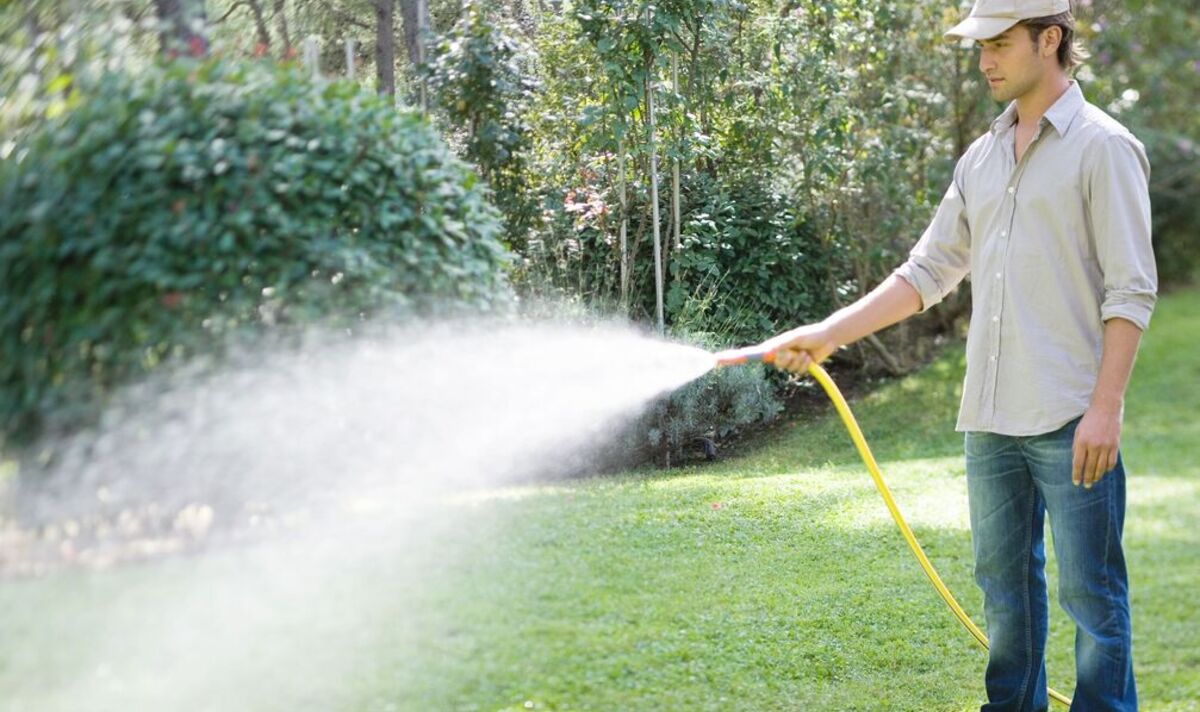Gardening: Lawns 'will survive without watering' says Tophill
Lawns obtain most of their water from the soil. If this is left to dry out for several days, grass growth will start to slow down.
If left without water any longer, lawns will go dormant and eventually dry out. In most cases, grass will start to grow again once they have access to water. However, allowing the grass to dry out will reduce the quality of lawns when the grass blades do start to grow again.
To avoid this, irrigation expert and director of Easy Garden Irrigation, Sean Lade, has shared the “best way to water your lawn in summer” as well as some of the different colours grass can turn and what this means.
The expert said: “A formal lawn is one of the most loved aspects of an English garden. During hot periods of weather, we are inundated with calls from homeowners seeking advice on how to keep their grass healthy and looking its best.
“How you water your lawn plays a big part in its health. Here are some tips on the best way to water your lawn during the summer months. For lawns less than 12 months old, you may want to seek some different advice.”

Don’t water your lawn too frequently
The expert claimed that once or twice a week is “more than enough” to keep lawns hydrated. Sean said: “We want the soil to get dry and the grass to be thirsty before we water it.” The expert claimed that the grass would ideally just start to have a “yellow tinge” and look as though it has “slightly lost its spring (stays flat after it has been stepped on rather than bouncing back)”.
For those who have a BBQ at the weekend and want to impress their guests, water the lawn before the big event “to get it looking its best”. Sean suggested that gardeners “try to stick to a consistent schedule for best results”.
Soak the lawn
Gardeners will need to apply an inch or two (around 25 to 50mm) of water to the lawn so it can sink down beyond the grass root zone.
Sean explained: “This helps the lawn develop deep roots and makes it more resistant to drought conditions. You can lay a small glass on the lawn to help you gauge how much water you are applying.
“If you have shaded areas that don’t get much sun, don’t soak them as much. If the lawn is so dry that the water starts to run off, water in stages across a couple of days.”
Don’t miss…
‘Worst’ watering mistakes to ‘avoid’ that are ‘detrimental’ your plants[EXPERT]
Four ‘effective home remedies’ to kill bed bugs and ‘eliminate an infestation’[INSIGHT]
‘Game-changing’ solution to ‘kill gravel weeds overnight’ and ‘remove moss’[TIPS]

Avoid watering during hot times of the day
The gardening expert said: “The best time of day for watering your lawn is either early morning or late evening to ensure you don’t lose water to evaporation. This helps prevent wasting water and helps the water penetrate deep.”
However, gardeners should also never water too late as the grass will remain wet as the temperature drops overnight and “can encourage disease in the lawn”.
Try to use rainwater when possible
Sean explained that rainwater has higher levels of nitrogen which “boosts growth”, and this way gardeners can avoid the dreaded hosepipe ban when it is enforced.
Gardeners need to bare in mind that if they plan to use rainwater to keep the garden watered during periods of drought, they will want to have an extra large water butt or rainwater harvester to ensure they have enough water for a couple of weeks for the period.
When it comes to identifying the health of a lawn, gardeners can use a colour chart to help them quickly see what health their lawn is in.
We use your sign-up to provide content in ways you’ve consented to and to improve our understanding of you. This may include adverts from us and 3rd parties based on our understanding. You can unsubscribe at any time. More info


Green lawns
The darker the green, the “healthier your lawn is”, claimed the expert. He noted: “You shouldn’t expect your grass to be dark green 24/7, but this is a sign that your lawn is very happy and healthy”.
Brown/red lawns
This is a sign the grass is stressed and gardeners should “take action as soon as possible”. A brown colour is usually a sign that the grass is dormant, a natural protection mechanism for grass to withstand weather changes. The grass is very tolerant and can recover from stress with just a bit of care and a regular watering regimen.
Orange lawns
Orange is not a natural colour found in grass. This is a sign that the grass is “suffering from rust disease”. Sean said: “The orange colour comes from the fungi spores on the leaves. This comes about in wet and warm conditions and when the grass has not been cared for properly.
“This can kill the leaves of your turf, but in general, will not kill the entire turf plant. To control this, invest in some lawn fertiliser, mow your turf properly, maintain good drainage and water your turf properly to the guidelines above.”
Silver/blue lawns
When turf turns a silvery blue shade, the expert claimed that this is the point when the lawn is “dead” and at this stage, “there is no recovery”.
Source: Read Full Article
